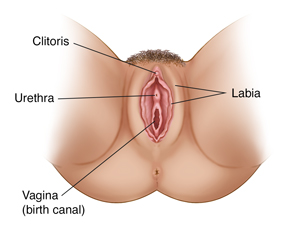Vulvodynia
Pain in a woman’s vulva is called vulvodynia. The vulva is the area of a woman’s outer sex organs. It includes the large and small folds of skin or lips (labia), the clitoris, and the openings of the birth canal (vagina) and urethra (where urine comes out). Some women feel pain in one specific spot. Others may feel pain in different areas or over the whole area.

What causes vulvodynia?
The exact cause of vulvodynia is not known. A number of factors may be involved. These may include:
-
Nerves in the area become injured or irritated over a long time.
-
Infections in the area cause your immune system to react in an unusual way.
-
Yeast or bacterial infections keep coming back.
-
You have allergies to certain foods or things in the environment.
-
Hormone levels are too high or too low.
-
Pelvic floor muscles are weak.
No matter what the cause, vulvodynia can be upsetting and affect all parts of your life. This includes both your physical and emotional health.
What are the symptoms of vulvodynia?
The major symptom is pain in the vulva that is present for at least 3 months. This pain can range from mild to severe. It can be in a specific area or affect the entire area. The pain can be burning, stinging, itching, or throbbing. The area may ache or feel swollen or sore.
The pain may occur suddenly or it can be set off (triggered) by an activity or contact with the vulva. Some common triggers include having sex, putting in a tampon, sitting for a long time, or wearing tight-fitting pants.
The pain can occur all the time or it can come and go. It can last for days but then suddenly go away. It can happen right away or sometime later after a trigger.
How is vulvodynia treated?
Often, the first step in treating this condition is to ease the symptoms with hygiene measures. Other treatments may include:
-
Medicines that you put on the area (topical), take by mouth (oral), or inject.
-
Relaxation and stress management to help with chronic pain and support emotional health.
-
Nerve blocks.
-
Pain management, such as trigger point therapy and transelectrical nerve stimulation.
-
Exercises to make the pelvic floor muscles stronger.
-
Counseling to help cope with chronic pain and for support about the effects of this condition on sexual health.
-
Complementary and alternative therapies, such as relaxation, massage, and acupuncture.
-
Surgery (rarely).
Hygiene tips for vulvodynia
Here are some helpful tips to help reduce the pain of vulvodynia:
-
Wear loose-fitting pants and skirts and all-cotton white underwear. Do not wear underwear when sleeping.
-
Wash undergarments in unscented, mild detergents. Don’t use fabric softener.
-
Don’t use feminine hygiene products, bubble baths, douches, or scented soaps or creams.
-
Wash your vulvar area with cool to lukewarm water only. Clean the area with water and pat it dry after urinating.
-
Use cool packs to the area or cool to lukewarm sitz baths to lessen itching, irritation, or burning.
-
Use a water-based lubricant when having sex.
-
Don’t sit in hot tubs or swim in pools that are high in chlorine.
Note:
We understand gender is a spectrum. We may use gendered terms to talk about anatomy and health risk. Please use this information in a way that works best for you and your health care provider as you talk about your care.
Online Medical Reviewer:
Irina Burd MD PhD
Online Medical Reviewer:
Marianne Fraser MSN RN
Online Medical Reviewer:
Tennille Dozier RN BSN RDMS
Date Last Reviewed:
1/1/2025
© 2000-2025 The StayWell Company, LLC. All rights reserved. This information is not intended as a substitute for professional medical care. Always follow your healthcare professional's instructions.